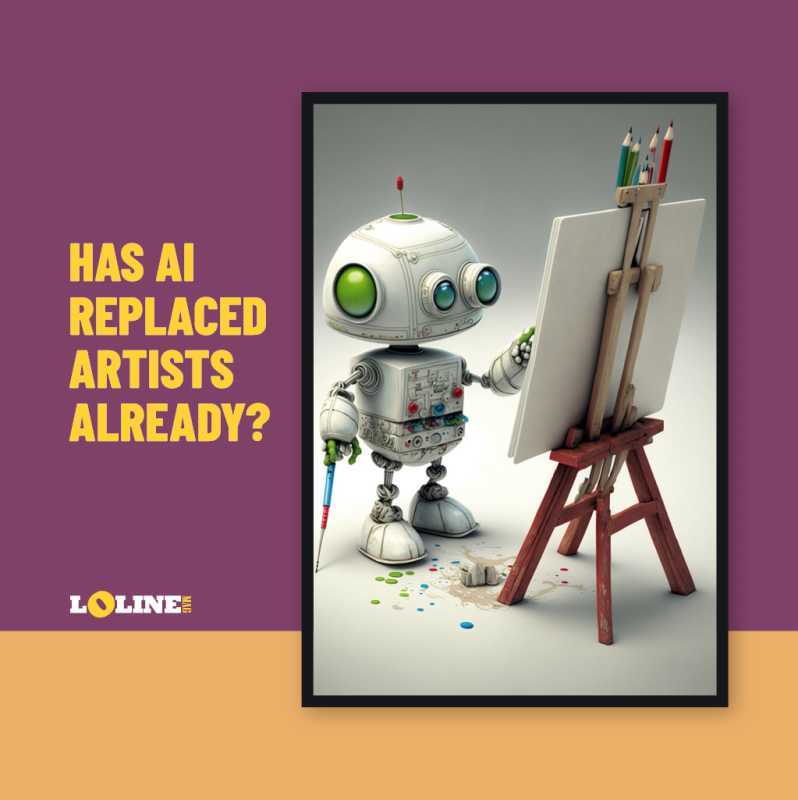AI In Digital Art - Has AI Replaced Artists Already?

You might ask if we all have the means to create art, then do artists have any use at all? Well, that all depends on your perception of art.
It is said that it took Leonardo Davinci 16 years to paint the “unfinished” Mona Lisa, his most-known masterpiece. You might wonder what Leonardo would think if he saw that it would now only take 5 minutes to create magnificent art. I guess he wouldn’t be too happy about it. AI art has been a source of amusement and controversy for people worldwide. With the development of such systems, one may no longer be required to have the skills needed to be an artist. This could be considered good news to some but an outrage to others.
History of AI in art
For decades, artificial intelligence has fascinated us. Contrary to popular belief, its influence on the arts is not new. AI art systems date back to the late 1960s; the first one was called AARON. Developed by the British artist Harold Cohen, AARON, a somewhat crude technology, produced low-fidelity black-and-white images that Cohen painted over. Since then, the progress of AI art systems has gradually decreased until the twenty-first century. In 2015, DeepDream, an AI-based image enhancer, was released by Google. Though there were hints about the new age of technology, nothing prepared us for what came next.
The use of prompt engineering in AI art created an exceptional advancement in the field. Several applications, including Midjourney, DALL-E, and DALL-E 2, were now collecting user text prompts and making graphics based on them. A paintbrush, a creative mind, and a skilled hand were no longer required. All that was required was a rudimentary notion articulated in a few words, and voila, a work of art was born.
The use of AI is currently branching out into other artistic fields such as music and writing. Several AI music-creation software programs are now making songs like any professional musician. AI writing is also progressing at an astounding rate, writing lyrics and essays in a blink of an eye.
Why is AI art so popular?
To answer that question, let's first talk about a man called Keith Haring. Haring was an American artist whose works were popular during the 1980s. While his paintings were original and authentic, his rebellious character made him more famous. He was often critical of the elitist art community and strongly believed art should be accessible to the masses. To achieve this, he painted murals in public places, printed his art on cheap t-shirts for his fans to buy, and collaborated with children on some of his major works. Haring’s rejection of the traditional establishment of art made him admired by many.
I sense a similar reason why AI art is popular. Apart from the obvious, AI has made art accessible to all. The exclusivity of traditional art is often considered a cause for dismay amongst many. AI created a system to “rebel” against exclusivity. Now, anyone is capable of creating a masterpiece. There is no need to commission expensive painters to possess magnificent art. Just type down your idea, and AI has got you covered.
Controversy in AI art
Understandably, this type of accessibility is bound to upset certain groups, and some of these concerns are legitimate. While the amount of effort put in greatly varies, AI art is competing against digital artists. Recently, AI-generated art won an art competition at the Colorado State Fair’s annual art competition. Events like these have created justified grievances among hard-working artists. Many artists criticized the unfair advantage AI gave people in the art industry. Some even fear AI might replace their line of work.
Is there no need for Artists?
You might ask if we all have the means to create art, then do artists have any use at all? Well, that all depends on your perception of art.
If you see art as purely an aesthetic endeavor, then maybe, yes, we may no longer need artists. AI can combine colors and draw lines with much higher precision than humans. But, art is not strictly limited to aesthetics. Art is a form of expression. Humans have used art to tell their stories, oppose or support ideas, and represent their experiences. Concepts like abstract art, absurdism, and symbolism are born out of the human experience. While AI can paint Michelangelo's creation of Adam, we can not interpret it with as much depth because AI has no motive to create art. The system is not driven by a muse but simply performs instructions.
Regardless of your opinion on AI art, it is impossible not to admire what it has been conjuring recently. The concerns tied to it are legitimate, and we are yet to see a formal ethical framework developed to incorporate AI into the arts. Nonetheless, we can continue to support industrious artists while having fun and making our own. AI growth is not slowing down anytime soon, and rather than one out-competing the other, it would be better for everyone if we find a way for both forms of art to coexist.
